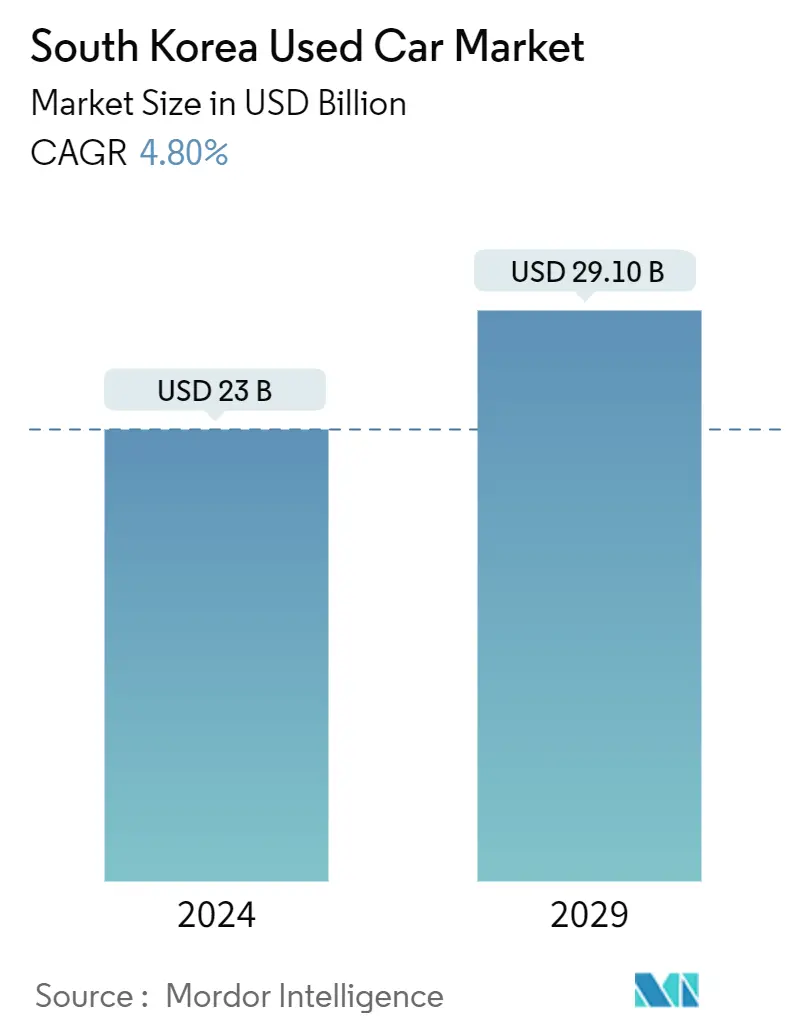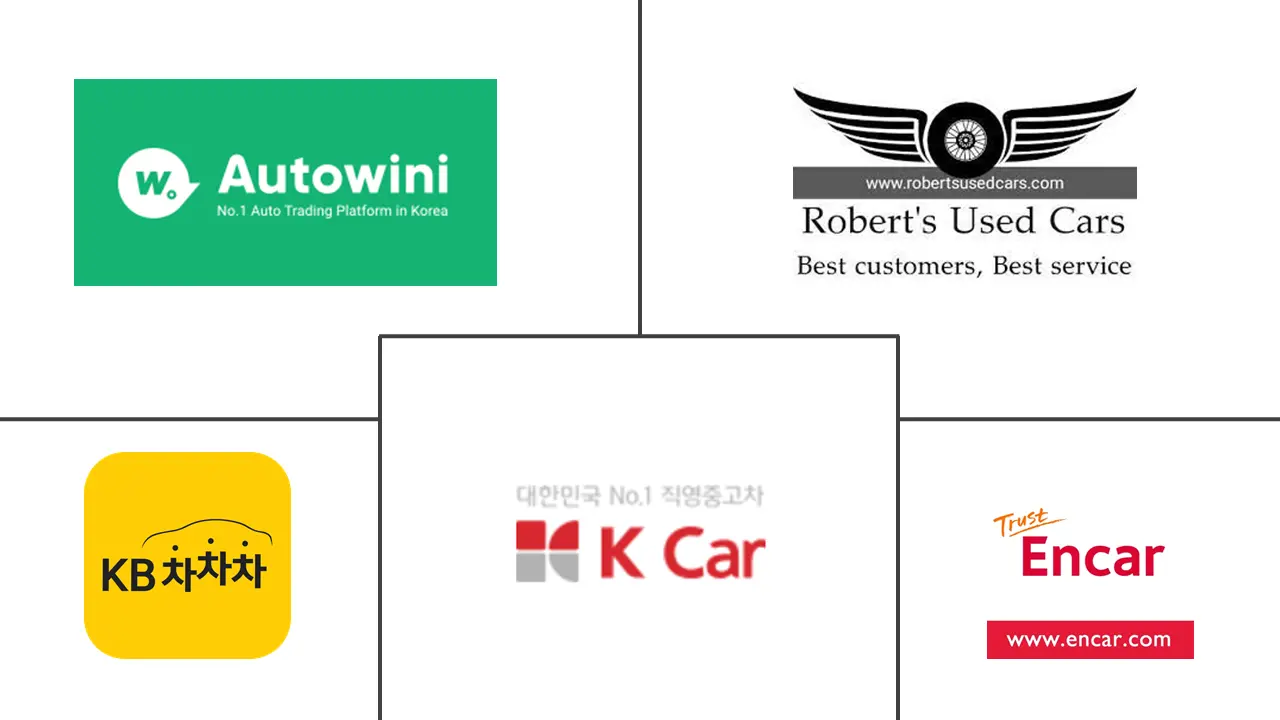Market Size of South Korea Used Car Industry

| Study Period | 2019 - 2029 |
| Base Year For Estimation | 2023 |
| Market Size (2024) | USD 23 Billion |
| Market Size (2029) | USD 29.10 Billion |
| CAGR (2024 - 2029) | 4.80 % |
| Market Concentration | Low |
Major Players
*Disclaimer: Major Players sorted in no particular order |
South Korea Used Car Market Analysis
The South Korea Used Car Market size is estimated at USD 23 billion in 2024, and is expected to reach USD 29.10 billion by 2029, growing at a CAGR of 4.80% during the forecast period (2024-2029).
The South Korean used car market was valued at USD 23.0 billion in 2023, and it is expected to reach USD 29.1 billion by 2028, projecting a CAGR of 4.8% during the forecast period (2023 - 2028).
- Consumers' growing preference towards availing private transportation medium owing to the increase in personal disposable income and GDP per capita, the emergence of online technologies, and increasing new vehicle prices serve as the major determinants for the growth of the used car market in South Korea. In 2022, the GDP per capita in South Korea stood at USD 34,997.8. Further, the monthly average income per household with one or more family members in South Korea stood at USD 3,660 during the April-June quarter of 2022, an increase of 12.7% during the same period in 2021.
- With the increasing financial stability, consumers prefer private transportation mediums to enhance their convenience for personal mobility. However, the spike in new vehicle prices deters some of these customers from purchasing brand-new vehicles, subsequently leading to the surging demand for used cars in South Korea.
- For instance, Hyundai Motor Corp and Kia Corp announced a strategy to increase the prices of all models launched in 2022 by an average of 5%, a more significant rate compared to their typical annual increase of 1-2%, primarily due to disruptions in the supply chain and semiconductor shortages.
- In the South Korean market, the sales of the lesser average-age used car models have witnessed an upward trend in 2022, rising from 12.9% in January to 15.5% in March, 17.9% in May, and 20.1% in August. Among these segments of used vehicles, the most popular model in terms of August 2022 purchase inquiries on the Encar platform was the Kia Carnival minivan, followed by the Hyundai Palisade SUV, Mercedes-Benz E-Class (W213), Kia Sorento SUV, Genesis G80 sedan (RG3), and Hyundai Grandeur IG sedan, among others.
- One of the major challenges faced by the used car market in South Korea is the presence of a large number of unorganized dealers offering lower prices than their counterparts, making the market highly fragmented and competitive. Further, the government in South Korea, for an extensive period, had banned big companies from selling secondhand vehicles, citing the need to protect smaller used car dealers.
- However, in recent years, the Ministry of SMEs and Startups implemented an initiative to allow these players to integrate into the market, with some conditions attached, such as limiting the market share. Coupled with that, declining used car prices serve as a major headwind for the South Korean Used Car Market.
- It is estimated that the average price of domestic used cars declined by 1.33% in January 2023 compared to December 2022. For instance, prices of secondhand cars dropped by 3.18 percent for Hyundai's Tucson (NX4) 1.6 Turbo 2WD Inspiration and 2.21 percent for Hyundai New Santa Fe 2.2 2WD Prestige during the same period.
- The government's aggressive strategy to promote the electrification of vehicle fleets and ban of petrol/diesel cars to promote the reduction in carbon emissions will aid the demand for used cars across South Korea during the forecast period. Consumers who are willing to purchase cheaper alternatives to new-energy vehicles are increasingly adopting the purchase of used vehicles for convenience in mobility. For instance, in March 2022, the South Korean government reaffirmed its plan to phase out sales of new internal combustion engine (ICE) vehicles by 2035. Further, in September 2022, the government announced the phasing out of Grade 4 diesel vehicles, the second-lowest in the country's five-tier emissions standard, from Seoul's central areas starting in 2025.
South Korea Used Car Industry Segmentation
A used car/pre-owned vehicle, or a secondhand car, is a vehicle that previously had one or more retail owners. A certified pre-owned (CPO) vehicle, on the other hand, is a pre-owned vehicle that has been extensively inspected (pre-purchase inspection) and expertly reconditioned. The used car market consists of a wide range of companies involved in the purchasing and selling of pre-owned vehicles through online or offline sales channels.
The South Korea used car market is segmented by vehicle type, vendor type, fuel type, and sales channel. By vehicle type, the market is segmented into hatchbacks, sedans, and sports utility vehicles (SUVs)/multi-purpose vehicles (MPVs). By vendor type, the market is segmented into organized and unorganized. By fuel type, the market is segmented into petrol, diesel, electric, and other fuel types (liquefied petroleum gas, compressed natural gas, etc.). By sales channel, the market is segmented into online and offline.
The report offers market size and forecast value (USD) for all the above segments.
| By Vehicle Type | |
| Hatchbacks | |
| Sedans | |
| Sports Utility Vehicles (SUVs)/Multi-Purpose Vehicles (MPVs) |
| By Vendor Type | |
| Organized | |
| Unorganized |
| By Fuel Type | |
| Petrol | |
| Diesel | |
| Electric | |
| Other Fuel Types (LPG, CNG, etc.) |
| By Sales Channel | |
| Online | |
| Offline |
South Korea Used Car Market Size Summary
The South Korean used car market is poised for significant growth, driven by factors such as increasing personal disposable income, the rise of online technologies, and the high cost of new vehicles. As consumers seek more convenient and cost-effective transportation options, the demand for used cars is expected to rise. The market is characterized by a high degree of fragmentation, with numerous domestic dealers competing intensely on pricing, online visibility, and value-added services. The government's initiatives to promote vehicle electrification and reduce carbon emissions are also influencing consumer preferences, leading to a growing interest in used electric vehicles. This shift is further supported by the declining prices of used electric cars, making them more accessible to consumers.
The adoption of advanced technologies and the expansion of e-commerce platforms are enhancing the online used car market in South Korea. With high internet penetration and rapid urbanization, consumers are increasingly turning to online platforms for their vehicle purchases, benefiting from comprehensive information and convenient transaction processes. Companies are actively integrating online spaces to offer improved services, such as detailed vehicle listings and instant financing options. Despite challenges like the presence of unorganized dealers and declining used car prices, the market is expected to continue its upward trajectory, supported by strategic initiatives from key players and the government's supportive policies.
South Korea Used Car Market Size - Table of Contents
-
1. MARKET DYNAMICS
-
1.1 Market Drivers
-
1.1.1 Rising Adoption of Digital Technologies
-
1.1.2 Others
-
-
1.2 Market Restraints
-
1.2.1 Presence of Various Unorganized Used Car Dealers in the Market
-
-
1.3 Industry Attractiveness - Porter's Five Forces Analysis
-
1.3.1 Threat of New Entrants
-
1.3.2 Bargaining Power of Buyers/Consumers
-
1.3.3 Bargaining Power of Suppliers
-
1.3.4 Threat of Substitute Products
-
1.3.5 Intensity of Competitive Rivalry
-
-
-
2. MARKET SEGMENTATION (Market Size in Value - USD)
-
2.1 By Vehicle Type
-
2.1.1 Hatchbacks
-
2.1.2 Sedans
-
2.1.3 Sports Utility Vehicles (SUVs)/Multi-Purpose Vehicles (MPVs)
-
-
2.2 By Vendor Type
-
2.2.1 Organized
-
2.2.2 Unorganized
-
-
2.3 By Fuel Type
-
2.3.1 Petrol
-
2.3.2 Diesel
-
2.3.3 Electric
-
2.3.4 Other Fuel Types (LPG, CNG, etc.)
-
-
2.4 By Sales Channel
-
2.4.1 Online
-
2.4.2 Offline
-
-
South Korea Used Car Market Size FAQs
How big is the South Korea Used Car Market?
The South Korea Used Car Market size is expected to reach USD 23 billion in 2024 and grow at a CAGR of 4.80% to reach USD 29.10 billion by 2029.
What is the current South Korea Used Car Market size?
In 2024, the South Korea Used Car Market size is expected to reach USD 23 billion.

